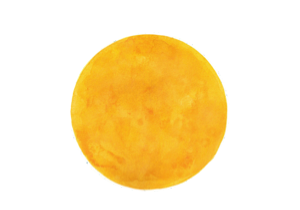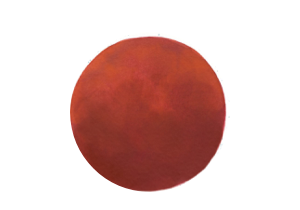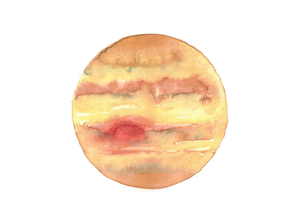How Many Planets Are There in the Solar System?
If you look at an astrology chart, there are ten planetary bodies to take notice of. Each planet rules different actions, life phases, and even body parts, so it's vital to understand how they function both in general, and in each astrological sign.

Your Birth Chart
It's important to note that the definition of a planet in astrology differs slightly from that in astronomy. Remember, astrology has been around for 2,000 years, and first observed with the naked eye. In the case of Pluto, for example, there has been much debate from modern astronomers as to whether its size classifies it as an official planet. It is currently dubbed a "dwarf planet," but when looking at an astrological chart, it holds the same weight as the rest of the interstellar team. The moon (a satellite of Earth) and sun (a star) are also considered planets for astrological purposes, though neither go through a retrograde period.
Why Are Planets so Important in Astrology—and What Do They Mean?
In astrology, planetary alignment is significant in more than one way. First of all, the position of the planets in the sky at the time of your birth reveal significant information about how you see the world, your habits and traits, belief systems, and strengths and weaknesses. Every planet rules over some general domains, giving astrologers insight into the way you function and interact with others. To put it simply, here's what each planet represents:
The Sun: Self-awareness & ego
The Moon: Inner emotional life
Mercury: Communication
Mars: Assertiveness & aggression
Venus: Love, beauty & money
Saturn: Responsibility, time & routine
Jupiter: Luck & opportunity
Uranus: Individuality & revolution
Neptune: Dreams, healing, & intuition
Pluto: Sex, death & transformation
Understanding planetary alignment also provides a useful guide for us to understand day-to-day life. As the planets move and orbit in the sky, they shift your focus in different ways. A Jupiter transit through your chart, for example, might bring you surprising opportunities in career, money, or even love. It's important to take notice when a planet is retrograde, or appearing to spin backwards, as it can shed some insight into what's to come. Think of the dreaded Mercury retrograde, when communication goes haywire! Taking note of where the planets are in both your personal astrological chart and in the sky on a regular basis allows you to make sense of events and emotions, and is a powerful tool that can help you allocate your physical and mental resources.
Natal, Social, and Generational Planets
When you look at your astrological chart, generally the first thing to take note of are the natal planets—those that have the quickest orbits and thus vary the most. These planets (the sun, the moon, Venus, Mercury, and Mars) are sometimes dubbed "personal planets," as they determine the relationships we have with ourselves and the people closest to us. Self-understanding, confidence, interpersonal relationships, personal desires, and communication style are all ruled by these celestial forces.
Bridging the gap between the inner and outer planets are Jupiter and Saturn—the social planets. This is quite a pair, as they both represent patterns, routines, and how we structure our lives. The social planets link us to the world by influencing our belief systems, sense of expansion, and philosophy.
The outer planets (Uranus, Neptune, and Pluto) are considered the generational planets. These planets have a slower orbit than the inner planets, and as such affect a larger group of people. For example, everyone born between November 1983 and November 1995 is in the Pluto in Scorpio generation. It is common for these groups to be united under common themes. They may share similar themes in music, art, and attitudes toward social mores.
Aspects and Alignments: How Planets Interact With Each Other
Just as our lives are affected by the people we interact with, energy can shift and transform based on the alignment of planets in the sky! And similar to how well (or not-so-well) you might vibe with certain people, planets can have clashes of their own. Some alignments, or "aspects," can be positive, while other aspects may be negative. There are seven major aspects to keep in mind:
Conjunction: Planets are considered conjunct when they are in the same astrological sign. This is a favorable planetary alignment that amplifies the energy of both planets.
Sextile: When planets are 60 degrees apart, they are considered sextile. This is also an easy placement that promotes harmony.
Trine: At 120 degrees apart, planets are trine. Another mellow planetary alignment that puts things at ease.
Semisextile: Semisextile planets are aligned at 30 degrees apart. This can cause some friction, as the planets will be located one sign apart with little in common.
Square: A difficult placement, planets that are square (or 90 degrees apart) tend to provoke extreme emotions and reactions. A planetary tug of war.
Quincunx: Planets at 150 degrees apart are in a quincunx position. While this isn't an all-out war, planets will be pulling you in opposite directions, creating the need for some major boundaries and a check in about priorities.
Opposition: When planets are 180 degrees apart in opposing astrological signs, they are opposite. While sparks can fly in this planetary alignment, it's also a nice opportunity for balance. Sometimes opposites attract!
What Does it Mean When a Planet Is 'in a Sign?'
While each planet represents a particular zodiac sign, they pass through all the signs as they transit the sky. When a planet is "in a sign," it brings a dose of its influence to the qualities of that sign. Think of it as a marriage between the two for that moment in the sky—whether it's a compatible one or not! For example, Mercury in Aries might make communication more fiery and impatient, while Venus in Leo will likely be a time of increased confidence and assertiveness.
In general, planets are most at home in the sign they rule (Jupiter in Sagittarius, for example), but there are benefits and downfalls to each sign—characteristics the planets are sure to emphasize with their own special touch.
With a shorter orbit, the inner planets (the sun, the moon, Mercury, Venus, and Mars) move more quickly through the signs, so we feel their presence more often.









